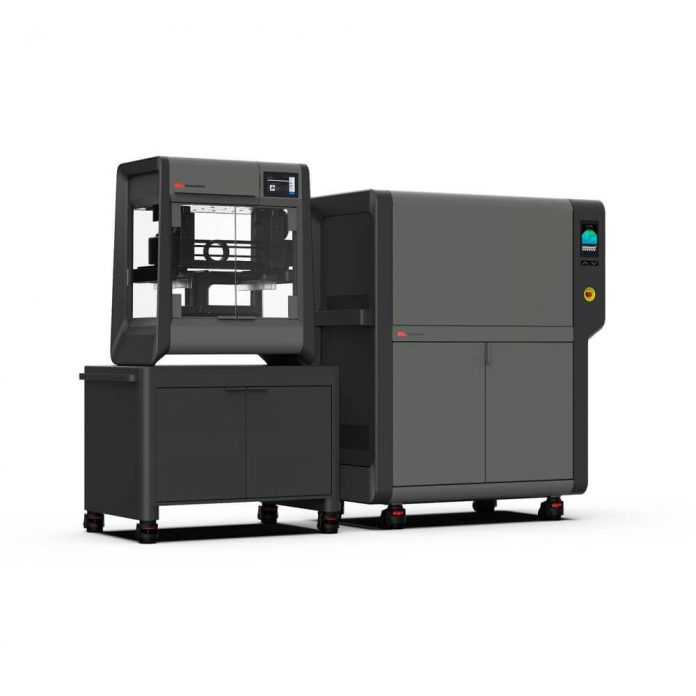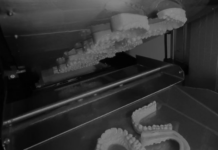Office-friendly metal additive manufacturing systems are on the rise. Next-Generation technology further simplifies metal 3D printing for low volume production with a breakthrough, two-step process.
Desktop Metal announced the launch of Studio System 2, a simplified, office-friendly metal 3D printing technology that offers customers the easiest way to print metal parts in low volumes for pre-production and end-use applications.
The Studio System, which first debuted in 2017, is an office-friendly metal additive manufacturing system that leverages the company’s proprietary Bound Metal DepositionTM (BMD) technology, a powder metallurgy-based process in which loose powders and dangerous lasers commonly associated with metal 3D printing are eliminated in favor of bound metal rods to shape parts layer-by-layer. The original Studio System, consisting of a printer, debinder and furnace, simplified in-house production of low volumes of complex, high-quality metal parts.
Shipping in volume since the fourth quarter of 2018, the Studio System has been adopted by hundreds of customers spanning more than 30 countries. Industry leaders like Ford Motor Company, BMW Group, Eaton Corporation, Google LLC, 3M Company, Stanley Black & Decker, Lockheed Martin Corporation, Goodyear Tire & Rubber Company, Moen Incorporated, and educational institutes such as Massachusetts Institute of Technology (MIT), Texas A&M University, and the Polytechnic University of Milan (Politecnico di Milano), are turning to the Studio System for a range of applications from pre-production functional prototypes to manufacturing low volumes of end-use parts.

The next-generation Studio System 2 retains all the critical features of the original Studio System, while delivering advancements that make metal 3D metal printing even easier, more reliable and accessible.
Benefits include:
Breakthrough, two-step process: Studio System 2 eliminates the use of solvents with all-new material formulations that allow parts to be transferred directly from the printer into the furnace. The result is an accessible two-step process with a nearly hands-free experience that also reduces consumables usage and overall system footprint.
Wide range of complex geometries: Designed to consistently deliver high-performance metal parts, Studio System 2 minimizes the trial and error common in alternative 3D printing processes, enabled by new print profiles and a re-engineered interface layer material for more even shrinkage during sintering and increased part success across an array of geometries.
Enhanced surface finish: The Studio System 2 printer’s heated build chamber and new print profiles produce outstanding surface finish right out of the furnace across side walls and support-facing surfaces.
High-strength, triply periodic minimal surface (TPMS) infill: New isotropic TMPS infill creates strong parts, ideal for end-use applications. Vacuum sintering in the Desktop Metal furnace at temperatures of up to 1400°C produces parts and mechanical properties that are similar to castings and meet or exceed Metal Powder Industries Federation (MPIF) standards.
Broad portfolio of materials: The Studio System 2 is launching with 316L stainless steel, an excellent corrosion resistant and general-purpose material used across a variety of industries for applications such as manifolds, nozzles, brackets, latches, and jewelry. A broad portfolio of additional materials that take advantage of the new streamlined, two-step process is in active R&D with new releases slated to rollout in 2021. In addition, the Studio System 2 will be backwards-compatible through the use of the debinder, with all materials previously supported by the Studio System, including 17-4PH stainless steel, 4140 low alloy steel, H13 tool steel, and Copper.
Software controlled workflow: Desktop Metal’s Fabricate software features new, default print profiles tailored to the Studio System 2 process that simplify build preparation while still providing users access to more than 90 customizable print settings. Fabricate also generates Separable Support structures with strategic splits to avoid locking during post-processing and fully automates thermal debind and sintering cycles.
The Studio System 2, which is set to begin worldwide shipments in the first quarter of 2021, will also be available through an upgrade for all existing Studio System customers.

















































